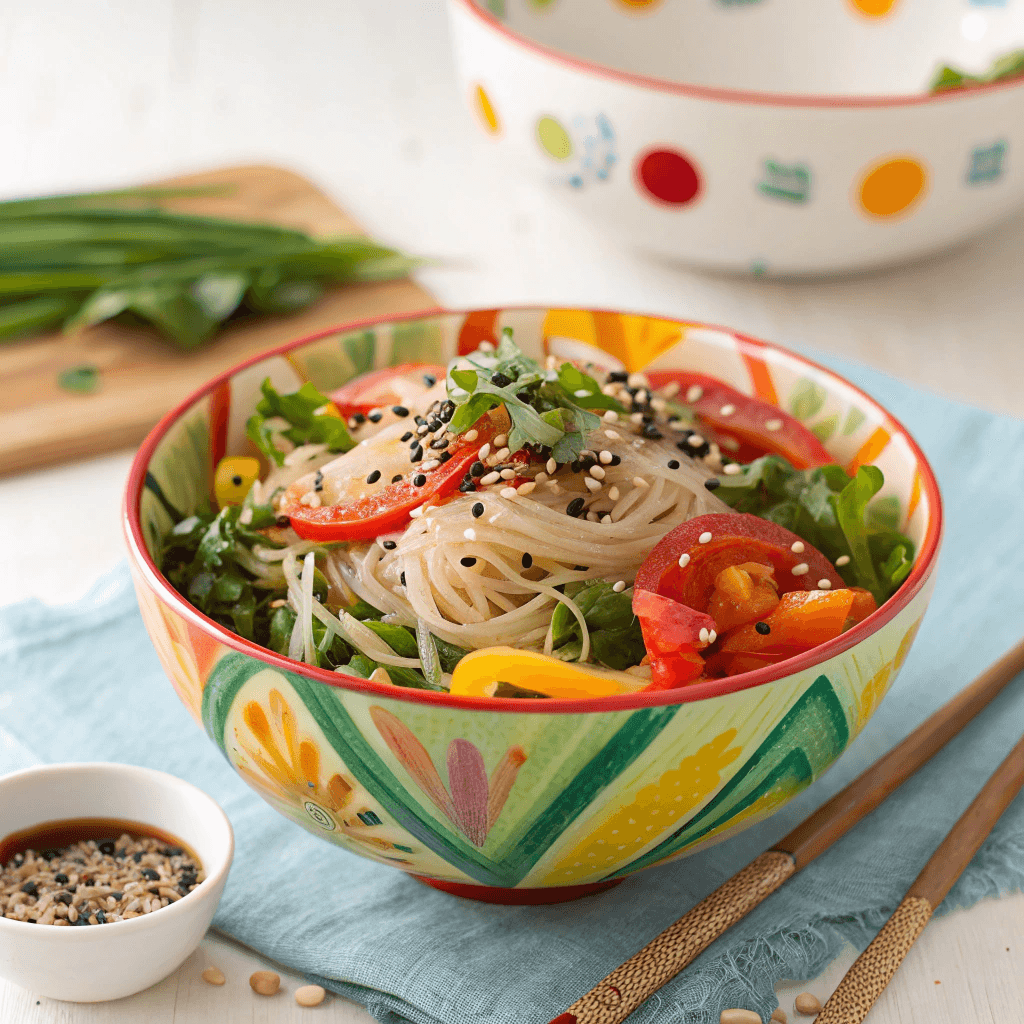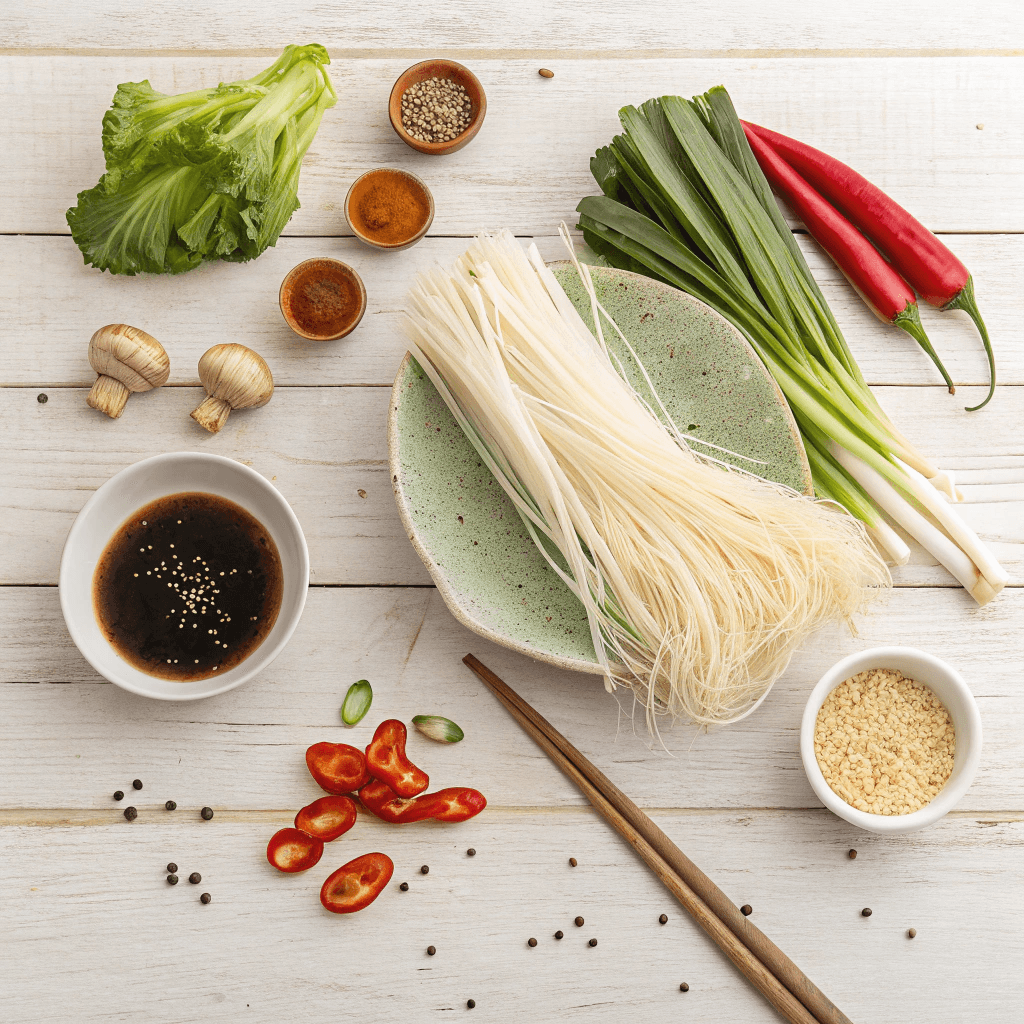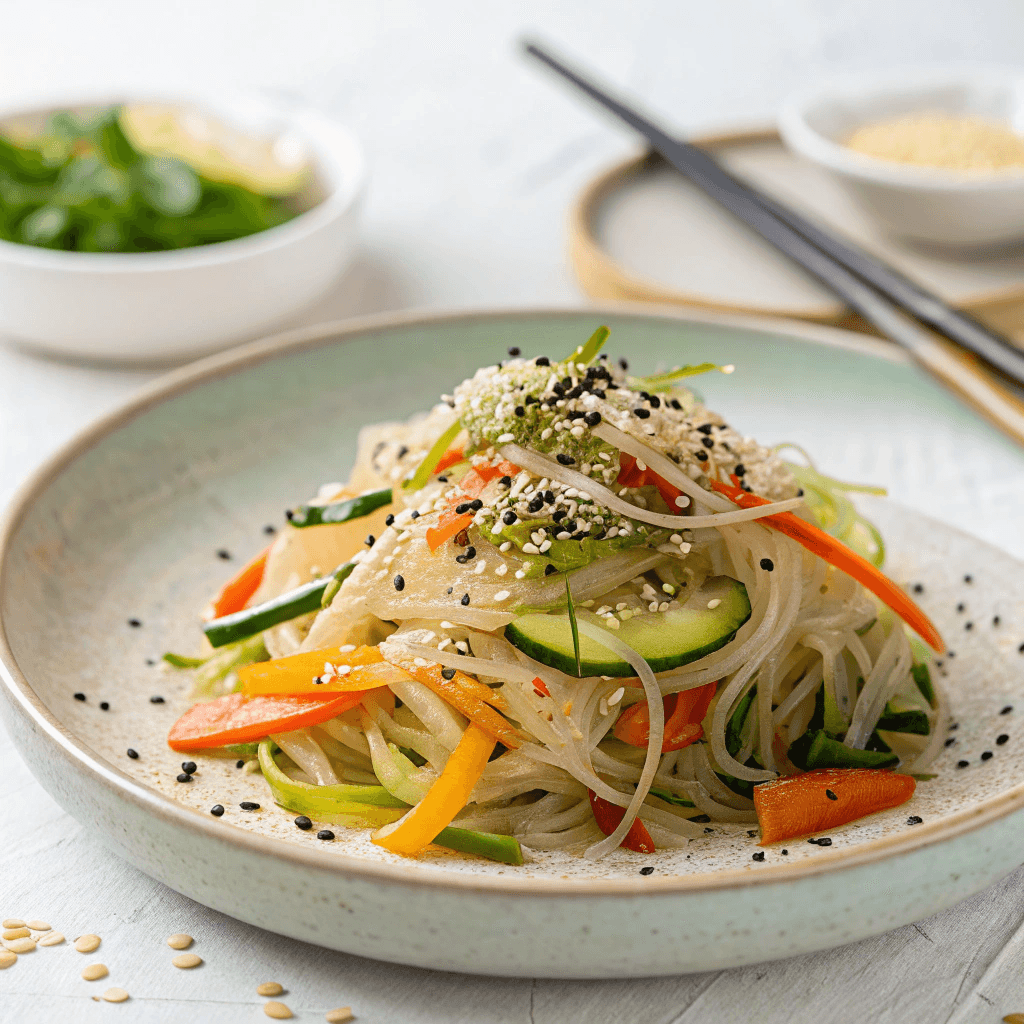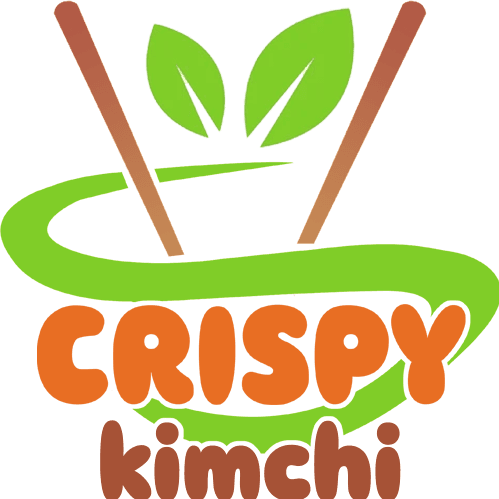Cheonsachae Salad : A 1 Unique Korean Delight
Discover the crunchy, refreshing taste of Cheonsachae Salad, a traditional Korean side dish made from seaweed noodles. This article dives into its origins, preparation, and more!
Have you ever encountered a salad so intriguing, its texture and origin alone make it a standout? Cheonsachae Salad, a traditional Korean dish like :
that you can also check, is exactly that. Furthermore, this dish, made from clear, noodle-like strands of processed kelp, offers a unique culinary experience that’s both crunchy and refreshing. Moreover, it’s gaining popularity not only for its distinctive qualities but also for its health benefits. In this article, we’ll explore the fascinating world of Cheonsachae Salad, from its historical roots to modern variations, guiding you through everything you need to know to make it yourself. Therefore, prepare to embark on a delicious journey as we delve into the details of this Korean delicacy.
Understanding Cheonsachae: The Foundation of the Salad
What Exactly Is Cheonsachae?
Cheonsachae, often referred to as “seaweed noodles”, is not technically a noodle in the traditional sense. Instead, it’s a processed food made from kelp or other types of seaweed. Additionally, it presents itself as translucent, noodle-like strands. Its unique appearance, coupled with its crunchy yet slightly chewy texture, makes it a fascinating ingredient. Furthermore, the flavor of cheonsachae is mild and slightly briny. The processing method involves extracting the algin from seaweed, then forming it into these distinctive strands. Therefore, you’re not eating regular noodles but rather a seaweed-based food product.
Historical Roots of Cheonsachae
Seaweed has been a staple in Korean cuisine for centuries. Consequently, the practice of preserving and processing it has ancient roots. Cheonsachae specifically, evolved from these traditions. Moreover, it’s become a common banchan, or side dish, served during meals. In addition, its historical role includes adding variety and a contrasting texture to the Korean dining experience. Furthermore, knowing this history enhances appreciation for its place in Korean culture. Therefore, appreciating its past helps you understand its modern appeal.
Cheonsachae Salad: From Traditional to Modern
The Classic Cheonsachae Salad Recipe
The traditional Cheonsachae salad is surprisingly simple, focusing on a balance of sweet, salty, and tangy flavors. Primarily, the base of the dressing consists of soy sauce, vinegar, sugar, sesame oil, garlic, and a touch of gochugaru (Korean chili flakes) for a gentle kick. First, the cheonsachae needs rehydrating in water. After that, it is essential to drain it thoroughly to prevent a watery salad. Therefore, the key is in balancing the dressing and ensuring the cheonsachae is prepared correctly.

Ingredients:
- 100g dried cheonsachae
- 2 tablespoons soy sauce (low sodium preferred)
- 2 tablespoons rice vinegar
- 1 tablespoon sugar
- 1 tablespoon sesame oil
- 1 clove garlic, minced
- 1/2 teaspoon gochugaru (Korean chili flakes, adjust to taste)
- 1/2 cucumber, julienned
- 1/2 carrot, julienned
- 2 scallions, chopped
Instructions:
- Rehydrate the Cheonsachae: Place the dried cheonsachae in a bowl and cover it with warm water. Allow it to soak for about 20-30 minutes, or until it has softened and become translucent.
- Drain the Cheonsachae: Once softened, thoroughly drain the cheonsachae in a colander. Gently squeeze out any excess water using your hands. This ensures the salad is not soggy.
- Prepare the Dressing: In a separate bowl, whisk together the soy sauce, rice vinegar, sugar, sesame oil, minced garlic, and gochugaru until the sugar is fully dissolved.
- Combine Ingredients: Place the drained cheonsachae in a mixing bowl and add the julienned cucumber, carrot, and chopped scallions.
- Dress the Salad: Pour the prepared dressing over the cheonsachae and vegetables. Toss everything gently to ensure the cheonsachae is evenly coated.
- Chill and Serve: Allow the salad to chill in the refrigerator for at least 15 minutes to allow the flavors to meld. Serve cold and enjoy
Exploring Regional Variations of Seaweed Noodles Salad
Interestingly, the recipes for Cheonsachae salad can vary slightly from region to region within Korea. Furthermore, these variations often involve the addition of different vegetables. For example, you might find recipes that include thinly sliced daikon radish, onions, or even bell peppers. In addition, some people add a small amount of gochujang for an extra depth of flavor. Moreover, these changes highlight the adaptability of the dish to local tastes. Therefore, experimenting with these variations is a great way to personalize your own recipe.
Modern Adaptations and Fusion Recipes
In recent years, chefs and home cooks have begun experimenting with Cheonsachae salad, integrating it into modern fusion dishes. In addition, some recipes now include non-traditional ingredients, such as avocado, fresh herbs like cilantro, or a splash of citrus juice for a brighter flavor. Furthermore, some modern interpretations also include spicy mayonnaise-based dressings. Therefore, the possibilities are endless when it comes to adapting the dish to your own liking. In conclusion, it shows the enduring nature of this versatile ingredient.
Key Ingredients and Smart Substitutions

This blog provides a comprehensive guide with clear pictures for preparing the dish. It’s great for those who want a visual guide.
https://mykoreankitchen.com/kelp-noodle-salad-cheonsachae-muchim
Choosing the Right Cheonsachae for your Seaweed Salad
When purchasing cheonsachae, it’s important to select a good quality product. For example, look for strands that are clear and evenly sized. Furthermore, Asian grocery stores and online retailers are the best places to find it. Also, it is essential to store dried cheonsachae in a cool, dry place. Additionally, buying from trusted sources will ensure you’re getting a quality product. Therefore, pay attention to the appearance of the product to ensure good quality.
The Role of Essential Dressing Ingredients for Seaweed Noodles Recipe
Each ingredient in the dressing plays a vital role in the final flavor. Therefore, soy sauce provides the saltiness, while rice vinegar adds acidity. Furthermore, sugar balances the tang, and sesame oil introduces a nutty aroma. Minced garlic and gochugaru bring a pungent and spicy kick, respectively. Also, you can use low-sodium soy sauce if you’re watching your salt intake. Similarly, agave or maple syrup are suitable substitutes for sugar. Therefore, experimenting with these elements will allow you to adjust the flavor perfectly.
Vegetable Choices and Protein Additions
Cucumbers, carrots, and daikon radishes are very popular vegetable additions, bringing crunch and freshness. Furthermore, you can also include scallions or chives for an extra layer of flavor. In addition, you can also add proteins like imitation crab, cooked shrimp, or other seafood. Alternatively, tofu or marinated mushrooms offer excellent plant-based options. Therefore, the vegetable and protein additions are very flexible to your preference.
Smart Substitutions for Dietary Needs
Substitutions are available for different dietary needs. For example, tamari or coconut aminos work well as gluten-free replacements for soy sauce. Also, maple syrup or agave can be used instead of sugar for vegan-friendly versions. Therefore, make suitable changes to ensure the dish meets your specific dietary requirements. Furthermore, remember to check the ingredient lists for allergens before use.
Health Benefits of Cheonsachae: A Nutritional Powerhouse
Low in Calories, Big on Flavor of this Korean dish
Cheonsachae is notably low in calories and carbohydrates, which makes it an ideal choice for those looking to manage their weight. Furthermore, it is a great alternative to traditional noodles. Also, it’s a satisfying choice for a healthy lifestyle. Therefore, incorporating Cheonsachae into your meals can be a great way to reduce your overall calorie intake.
Nutrient-Rich Profile of Seaweed Noodles
The nutritional content of Cheonsachae comes from its seaweed base, providing essential minerals, such as iodine and calcium. In addition, it’s a good source of dietary fiber which aids in digestion. Additionally, it contains antioxidants and other beneficial compounds. However, it’s essential to remember that Cheonsachae should be consumed as part of a varied and balanced diet.
Considerations and Precautions
The iodine content in Cheonsachae may be a concern for individuals with thyroid issues. Therefore, those with thyroid problems should consult their healthcare provider before consuming large quantities. Also, it’s always best to enjoy this food in moderation as part of a diverse diet.
Nutritional Content (per 100g)
| Nutrient | Amount |
| Calories | 10-20 |
| Carbohydrates | 2-4 g |
| Fiber | 2-3 g |
| Iodine | Varies, but a good source |
| Calcium | Varies, but present |
How to Best Serve and Enjoy Cheonsachae Salad

Serving suggestions
Traditionally, Cheonsachae salad is served as a banchan or side dish in a Korean meal. However, it’s also an excellent option as a refreshing appetizer or a light lunch. Therefore, it is versatile enough to be used in various meals. Also, it provides a great textural contrast to richer dishes.
Flavor Pairings
The sweet, savory, and tangy profile of this salad makes it compatible with a wide array of flavors. Therefore, it pairs well with both Korean and Western dishes. Furthermore, the coolness of the salad also makes it a great accompaniment to spicy dishes. Also, its versatility allows for various culinary combinations.
Storage Tips to Maintain Freshness
Prepared Cheonsachae salad can be stored in the refrigerator for up to two days, but it’s best to consume it within a day to ensure optimal texture and flavor. Furthermore, it’s essential to store it in an airtight container to prevent it from drying out. Also, the texture of the cheonsachae might change slightly with storage. Therefore, it’s ideal to eat this salad when it’s freshly made.
Where to Find Cheonsachae and its Ingredients
Navigating Asian Grocery Stores
Asian grocery stores are the best places to find Cheonsachae and other specialty ingredients. Moreover, be sure to ask the staff if you can’t find them easily. Additionally, these stores often have a wide range of Korean products that may be hard to find elsewhere. Therefore, exploring the aisles can often lead to discovering new culinary treasures.
Online Shopping for Korean Ingredients
Online retailers have made it easier to purchase cheonsachae and other Korean ingredients without having to physically visit a store. Therefore, these online stores provide greater access and convenience. Also, consider looking at websites specializing in Korean foods. Furthermore, remember to check the reviews before purchasing from a new online store.
Local Options and Substitutes
If Asian grocery stores are not available, consider looking at your local markets. Although it may not have cheonsachae, there are options for suitable replacements. However, purchasing online remains the more effective approach if you wish to have the proper Cheonsachae. Therefore, understanding the ingredients can help you improvise.
Conclusion
Cheonsachae Salad is a testament to the diversity and depth of Korean cuisine. Furthermore, its unique texture, flavor, and health benefits make it an appealing dish for anyone looking to explore new culinary experiences. Additionally, its versatility allows for creative adaptations. Therefore, we encourage you to try making this at home. In conclusion, it will broaden your culinary horizons.
Frequently Asked Questions (FAQs)
Do you eat Korean noodle salad hot or cold?
Korean noodle salads, like Cheonsachae salad, are typically served cold. This enhances the refreshing nature of the dish and its crunchy texture. The cold temperatures also help the flavors to meld together nicely, making the salad more enjoyable. Therefore, serving cold enhances its refreshing qualities.
Do kelp noodles have nutritional value?
Kelp noodles, like cheonsachae, are indeed nutritious. They are low in calories and carbohydrates, which are helpful in weight management, also, they are a source of dietary fiber and important minerals such as iodine and calcium. Therefore, they are an excellent addition to a healthy diet.
Table of Contents
Cooking is an act of love and creativity! 🌟 What do you think of this recipe? I’d love to hear your thoughts and any tips or tweaks you’d suggest to make it even better. Let’s inspire each other in the kitchen!
There are no reviews yet. Be the first one to write one.







